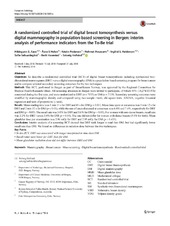| dc.contributor.author | Aase, Hildegunn Siv | en_US |
| dc.contributor.author | Pedersen, Kristin | en_US |
| dc.contributor.author | Houssami, Nehmat | en_US |
| dc.contributor.author | Haldorsen, Ingfrid S. | en_US |
| dc.contributor.author | Sebuødegård, Sofie | en_US |
| dc.contributor.author | Hanestad, Berit | en_US |
| dc.contributor.author | Hofvind, Solveig | en_US |
| dc.contributor.author | Holen, Åsne Sørlien | en_US |
| dc.date.accessioned | 2019-03-18T16:37:33Z | |
| dc.date.available | 2019-03-18T16:37:33Z | |
| dc.date.issued | 2018-08-29 | |
| dc.Published | Aase HS, Holen åS, Pedersen K, Houssami N, Haldorsen IS, Sebuødegård S, Hanestad B, Hofvind S. A randomized controlled trial of digital breast tomosynthesis versus digital mammography in population-based screening in Bergen: interim analysis of performance indicators from the To-Be trial. European Radiology. 2019;29:1175–1186 | eng |
| dc.identifier.issn | 0938-7994 | |
| dc.identifier.issn | 1432-1084 | |
| dc.identifier.uri | https://hdl.handle.net/1956/19221 | |
| dc.description.abstract | Objectives To describe a randomized controlled trial (RCT) of digital breast tomosynthesis including synthesized two-dimensional mammograms (DBT) versus digital mammography (DM) in a population-based screening program for breast cancer and to compare selected secondary screening outcomes for the two techniques. Methods This RCT, performed in Bergen as part of BreastScreen Norway, was approved by the Regional Committees for Medical Health Research Ethics. All screening attendees in Bergen were invited to participate, of which 89% (14,274/15,976) concented during the first year, and were randomized to DBT (n = 7155) or DM (n = 7119). Secondary screening outcomes were stratified by mammographic density and compared using two-sample t-tests, chi-square tests, ANOVA, negative binomial regression and tests of proportions (z tests). Results Mean reading time was 1 min 11 s for DBT and 41 s for DM (p < 0.01). Mean time spent at consensus was 3 min 12 s for DBT and 2 min 12 s for DM (p < 0.01), while the rate of cases discussed at consensus was 6.4% and 7.4%, respectively for DBT and DM (p = 0.03). The recall rate was 3.0% for DBT and 3.6% for DM (p = 0.03). For women with non-dense breasts, recall rate was 2.2% for DBT versus 3.4% for DM (p = 0.04). The rate did not differ for women with dense breasts (3.6% for both). Mean glandular dose per examination was 2.96 mGy for DBT and 2.95 mGy for DM (p = 0.433). Conclusions Interim analysis of a screening RCT showed that DBT took longer to read than DM, but had significantly lower recall rate than DM. We found no differences in radiation dose between the two techniques. Key Points • In this RCT, DBT was associated with longer interpretation time than DM • Recall rates were lower for DBT than for DM • Mean glandular radiation dose did not differ between DBT and DM | en_US |
| dc.language.iso | eng | eng |
| dc.publisher | Springer | eng |
| dc.rights | Attribution CC BY | eng |
| dc.rights.uri | http://creativecommons.org/licenses/by/4.0/ | eng |
| dc.subject | Mammography | eng |
| dc.subject | Breast cancer | eng |
| dc.subject | Mass screening | eng |
| dc.subject | Digital breast tomosynthesis | eng |
| dc.subject | Randomized controlled trial | eng |
| dc.title | A randomized controlled trial of digital breast tomosynthesis versus digital mammography in population-based screening in Bergen: interim analysis of performance indicators from the To-Be trial | en_US |
| dc.type | Peer reviewed | |
| dc.type | Journal article | |
| dc.date.updated | 2018-12-20T11:04:58Z | |
| dc.description.version | publishedVersion | en_US |
| dc.rights.holder | Copyright 2018 The Authors | |
| dc.identifier.doi | https://doi.org/10.1007/s00330-018-5690-x | |
| dc.identifier.cristin | 1617798 | |
| dc.source.journal | European Radiology | |

